
Motorhome vs. Travel Trailer
RVing in a Motorhome vs. Travel Trailer
See how one couple compares both experiences.
By: Jordan & Brittany Griggs
One of the most common questions we receive from interested future RVers is, "Why did you choose a motorhome over a travel trailer?"
It's a question we've contemplated quite extensively, and one my wife Brittany and I also asked ourselves a few years ago before jumping into the RV lifestyle. After a good deal of back and forth, our first purchase actually landed us with a 28-ft travel trailer that we pulled with a half-ton diesel truck.
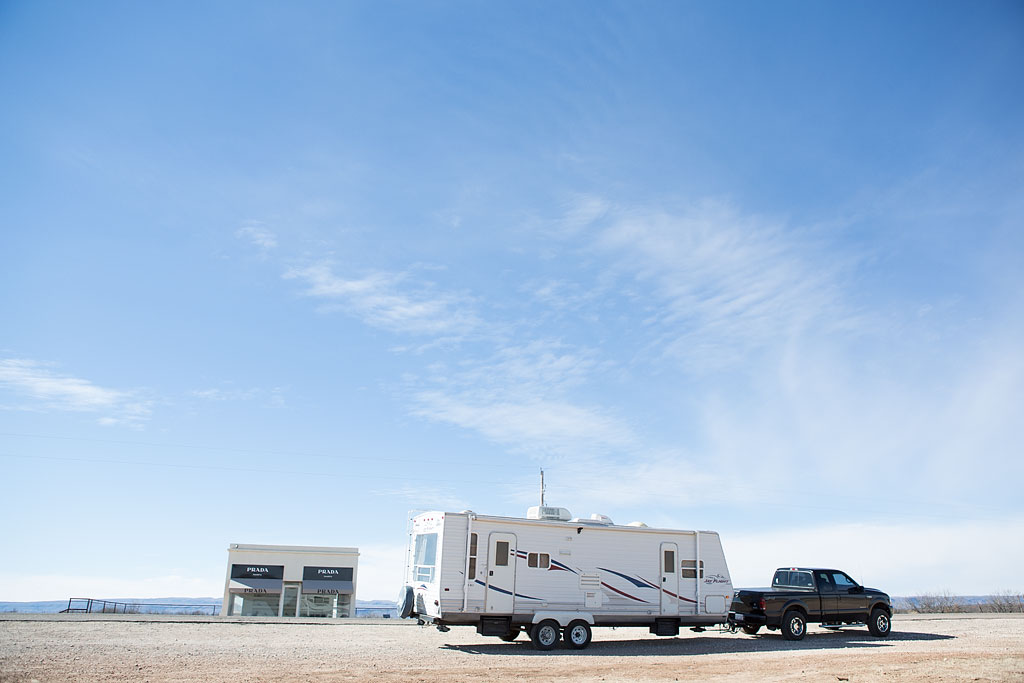 Our former truck/travel trailer combo, parked outside a Prada store art exhibit (Marfa, Texas)
Our former truck/travel trailer combo, parked outside a Prada store art exhibit (Marfa, Texas)
We lived and traveled throughout North America in the combination for the duration of 2016, before more recently switching to a 24-ft Winnebago View. We also live in the View while we travel across America for our 2017 project, The Ultimate Golf Road Trip.
While we don't claim to be seasoned RV veterans, our research and experiences traveling in both a small motorhome and a travel trailer have lent us a great perspective to address this common question.
The short answer? It all depends on your wants and needs. Below we take a look at some of the most important considerations and specifically compare a Class C motorhome to a mid-sized travel trailer.
Review Winnebago Class C motorhomes and browse Winnebago towables.
Motorhome vs. Travel Trailer Cost
1) Upfront Cost
Simply put, a class C motorhome is sure to cost more than a like-condition travel trailer. There are a lot of variables that can come into play here (i.e. new vs. used, the need to purchase a vehicle capable of towing the travel trailer, etc.), but generally speaking, a travel trailer can be acquired for less.
For example, we initially purchased a used 2007 travel trailer and a used 2002 diesel truck. Including renovations and a few upgrades, our initial cost was around $33,000. By comparison, our used 2012 Winnebago View was nearly double that upfront cost (although it is a much newer unit).
Comparing a new class C to a new travel trailer/truck combination, you'd likely arrive at prices that are much closer in value, but the bottom line is if you're on a tighter budget, the travel trailer can certainly provide an attractive price point.
2) Ongoing Maintenance
As you might expect, the ongoing maintenance of the class C motorhome tends to be higher than a travel trailer. In part, because you have both the RV components and the vehicle components (i.e. engine, filters, etc.) to maintain. This cost will fluctuate with the frequency of use (and luck!), but for full-time traveling, we've budgeted around $200-250 a month on average for our View, and about a quarter of that amount for the travel trailer/truck combo.
Learn more about RV maintenance.
3) Fuel
Powered by a diesel engine, we get around 15-16 mpg in the class C motorhome (with no tow car) compared to 10-11 mpg pulling the travel trailer. Though you might see a slight decrease in the 15-16 mpg if you pull a tow vehicle, you could enjoy zipping around town at 40+ mpg with a fuel-efficient car for use once parked.
Get tips for saving money on fuel while RVing.
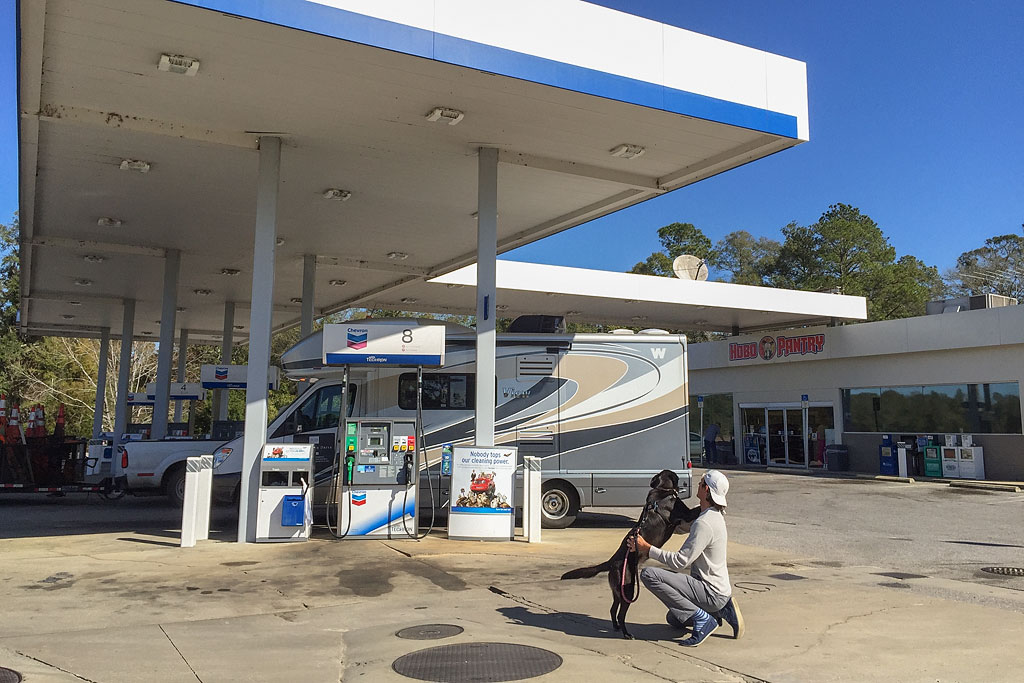 No truck stop needed with the class C Winnebago View; any gas station will do!
No truck stop needed with the class C Winnebago View; any gas station will do!
4) Depreciation & Resale Value
We often hear that cars are a "terrible" investment. Why? Well, when's the last time you sold a car for more than the purchase price!? Both motorhomes and travel trailers sit on wheels and fall into that dark category of a depreciating asset -- you will, inevitably, likely sell either for significantly less than purchased.
However, you may experience less (or slower) depreciation in a travel trailer, because it doesn't have an engine, like a motorhome. In fact, we ended up selling our travel trailer one-year after purchase for a few hundred dollars more than the overall purchase cost. It's a topic that can be addressed from various angles -- for more on how to think about the depreciation and resale topics, check out A Business Approach to Buying a Motorhome.
Travel Days in a Motorhome vs. Travel Trailer
1) Frequency of Use
While long-term RVers like ourselves get their money's worth, those who purchase for part-time use like weekend trips and annual vacations need to consider how frequently they'll be out on the road. A Class C can be a big investment if it's only being used a few weeks out of the year, and it may be less painful to see a less expensive travel trailer sitting idle in the driveway.
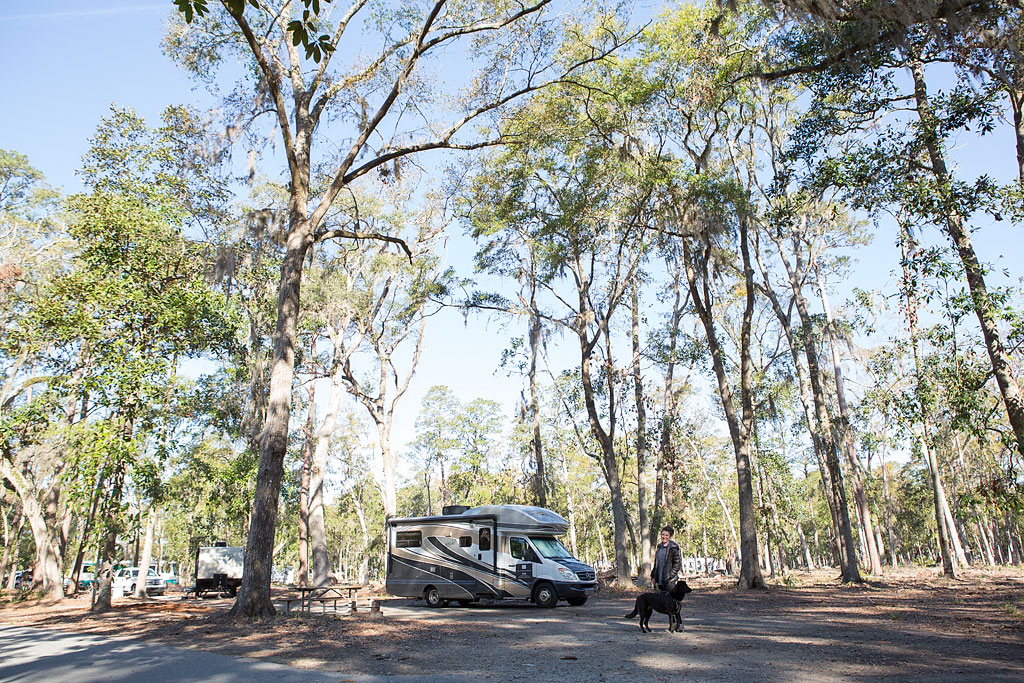 Consider how often you'll be able to do trips like this (Fort McAllister State Park, Savannah, GA)
Consider how often you'll be able to do trips like this (Fort McAllister State Park, Savannah, GA)
I will note that there are ways to get creative and earn income while you're motorhome (or trailer) isn't in use. New companies like Rvshare.com make it easy for RV owners to rent out their units while not in use.
2) Accessibility
I vividly recall our first "wrong turn" into a crowded Chick-fil-a parking lot while pulling our 28-foot travel trailer. While we did come out unscathed, it was a dicey situation, to say the least! With our class C Winnebago View, we have no issues whipping in-and-out of crowded areas with relative ease.
The compact nature of the class C motorhome allows far greater flexibility than a trailer during "travel days." It makes the little things like stopping to fill up gas, to more impactful experiences like the ability to drive iconic Highway 1 on the California coast, more accessible and possible than when pulling a travel trailer from destination to destination.
3) Comfort while driving
When you've got an all-in-one unit like the class C motorhome, things like napping, bathroom breaks, grabbing a quick snack, and working from the "office" (aka dinette table) are all still possible without a stop required. Brittany routinely enjoys these activities while I continue to pilot the drive to our next destination. These all require a stop when traveling with a trailer.
 Brittany's workstation during travel days in our View. Built in seat-belts make for a safe journey, too!
Brittany's workstation during travel days in our View. Built in seat-belts make for a safe journey, too!
Also, the compact Class C is very easy to drive (in my opinion, it maneuvers much like a large SUV) relative to pulling the travel trailer. I used to do all the driving (yes, all 20,000 miles in 2016!), but Brittany is able to comfortably drive our Winnebago View, allowing us to split driving time.
One other key factor is driving speed. Though I sometimes see others ripping down the highway with their trailers, we were never comfortable going faster than 62-65 mph -- especially in windy conditions. In the Class C, we're able to drive the speed limit, which comes in handy for those 75-80 mph speed zones you often find in less populated areas of the country. It makes a big difference over the course of a few driving days.
 Brittany at the helm of our Winnebago View. The compact nature of the Class C makes for easy driving.
Brittany at the helm of our Winnebago View. The compact nature of the Class C makes for easy driving.
Comparing Motorhome vs. Towable Camping
1) Living space and storage
Although the Class C View has a great use of space, at the end of the day we're still talking about 150-sq feet of livable area. We've gotten used to small spaces, but it doesn't compare to our 28-foot travel trailer that boasted 275-sq feet. Perhaps the toughest adjustment going from a full queen-sized bed to a much smaller mattress in the class C (especially when the dog and cat insist on joining). If you're only in your rig for a few days or week at a time, space may not be a big deal. But for longer stays, be sure you're comfortable with the size.
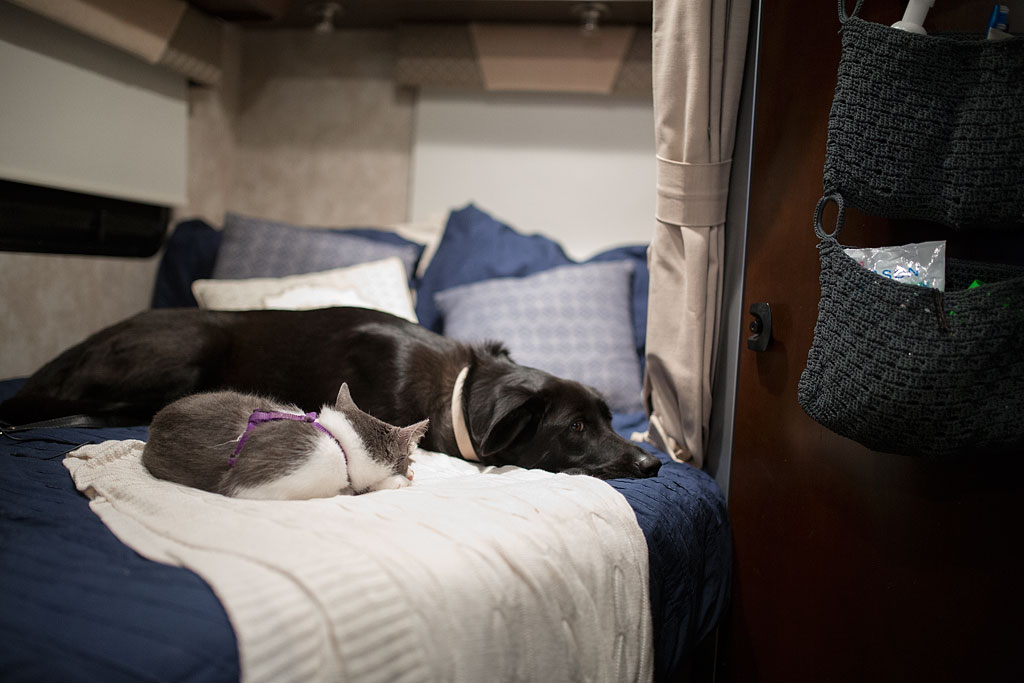 Room for us, mom and dad? Sometimes we miss the queen-sized mattress offered by our travel trailer.
Room for us, mom and dad? Sometimes we miss the queen-sized mattress offered by our travel trailer.
Before any purchases, head to an RV dealership to walk through various models of both motorhomes and travel trailers. It will give you a good sense of what is doable for your lifestyle.
2) Go-go-go vs. stay and play
Once you arrive at your destination, the set-up is pretty quick and easy with a class C. Pull or back into the spot, ensure you're level and hook up to water/power/sewer (assuming you're at a campground/RV park). A travel trailer requires the same steps, with the added step of unhooking the chains, sway bars and hitch.
It's not a big deal if you're not moving around much, but for those planning to go-go-go, it's enough of a burden to quickly make you consider a class C. On the flip side, if you'll be staying in one location and exploring the area, without a tow car, you'll need to drive the class C around town. It's a slight inconvenience, but setup is so quick it hasn't been a big deal for us. Also, a few bicycles can make all the difference!
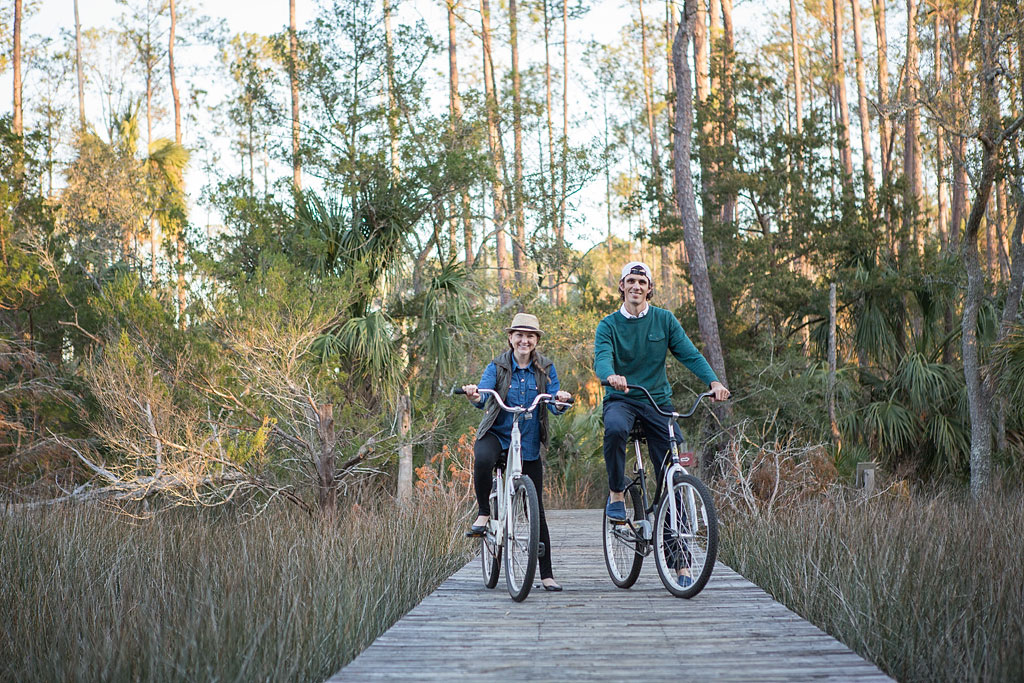 No tow car, no problem! Bikes can be a fun way to explore (or run a quick errand) while parked
No tow car, no problem! Bikes can be a fun way to explore (or run a quick errand) while parked
3) Be our guest
It's fun to travel or camp with others, but the more people along for the ride means the more cramped living quarters become. Most class C motorhomes sleep 4-6 people, while travel trailers can sleep upwards of 8-10 (depending on layout).
We found that 4 people in our travel trailer were no big deal, however it makes for pretty tight quarters in our Winnebago View.
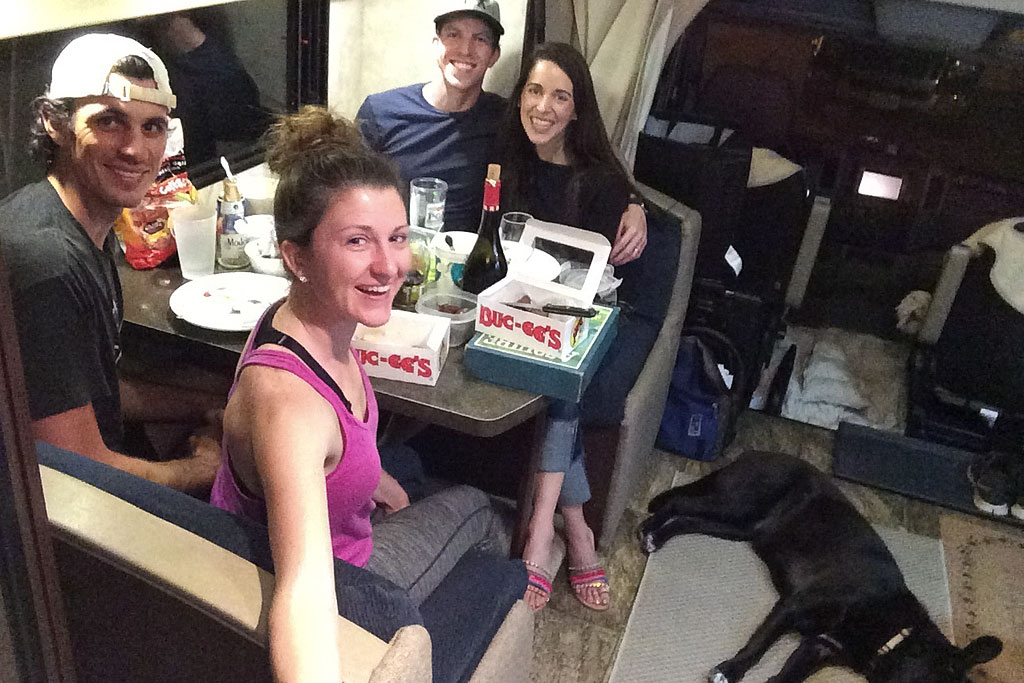 It's not as spacious, but entertaining dinner guests in our View is still possible and fun!
It's not as spacious, but entertaining dinner guests in our View is still possible and fun!
So which one trumps the other: class C motorhome or travel trailer? Well, as the old saying goes, it's all in the eye of the beholder. Evaluate which aspects are most important to you and will best suit your own personal needs. Either way, I can promise that the experiences and memories you'll create RVing, are well worth the investment.
 Nothing beats the experience of traveling by RV (Biloxi, Mississippi)
Nothing beats the experience of traveling by RV (Biloxi, Mississippi)
Comments
Comments on this post are moderated, so they will not appear instantly. All relevant questions and helpful notes are welcome! If you have a service inquiry or question related to your RV, please reach out to the customer care team directly using the phone numbers or contact form on this page .